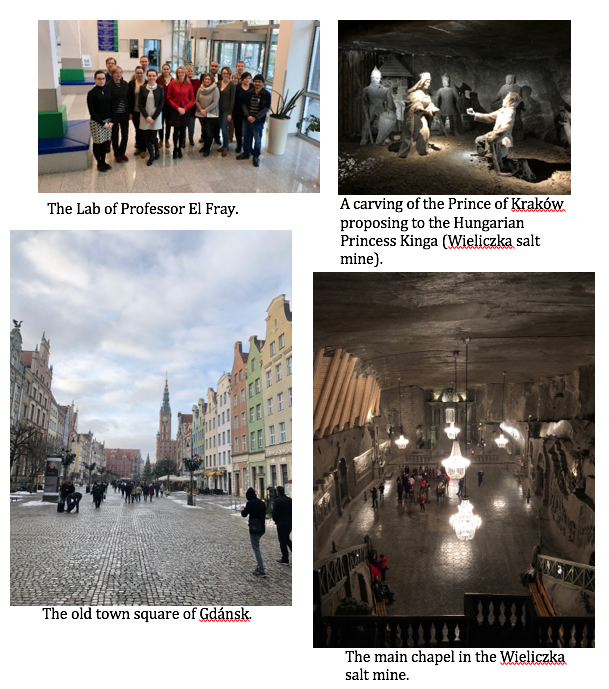Below, Catherine Miles gives her account of her trip to Poland.
I was given the opportunity to do a research exchange in the lab of Professor Mirosława El Fray at the West Pomeranian Institute of Technology in Szczecin Poland. For 5 weeks I worked with a fellow PhD student, Ola, on a project that focused on the enzymatic synthesis of poly(butylene succinate-co-dilinoleic succinate) (PBS-DLS). This polymer can be electrospun into fibrous mats and used as a 3D synthetic porous scaffold for myocardium tissue replacement. Using an enzyme for polymer synthesis is a “green chemistry” approach and is currently an emerging field of research. There are several benefits of using an enzyme to synthesis polymers: higher selectivity thereby avoiding side-product reactions, milder temperature conditions are required, and the enzyme is often reusable. During my time in Professor El Fray’s lab, Ola and I performed several synthesis reactions at varying weight percent compositions of the PBS and DLS segments. The next step of the project is to use the polymer to create fibrous electrospun mats and to evaluate the morphology, chemical and mechanical properties and degradation timeline and products to determine the most appropriate PBS-DLS weight percent composition that mimics natural myocardium tissue.
During my time in Poland I was able to do a little exploring. I first traveled to Gdánsk, a town located in the North East of Poland. Founded in the 10th century, Gdánsk was a desirable port city and since the 1300s was ruled by the Teutonic Knights, Prussia, Germany, the Soviet Army, and Poland. On September 1st at the Westerplatte peninsula in Gdánsk, the first shots were fired by a German battleship signifying the start of WWII. In 1945, Gdánsk, like many Polish cities was rebuilt from the rubble and restored with an emphasis on replicating the architecture once found in the city. Today Gdánsk is celebrated as the birthplace of Daniel Fahrenheit and Johanna Schopenhauer, home to the biggest working crane in the world in the mid 1400s, and is today’s capital of amber. My next weekend, I travelled to Warsaw, the capital of Poland. Warsaw is well known for its Jewish history and the Warsaw uprising in August 1944. At the end of WWII, 95% of central Warsaw was completely destroyed. Today, Warsaw is the largest city in Poland and contains numerous universities, churches, and museums and is the birthplace of Marie Skłodowska Curie and Frédéric Chopin. Warsaw also contains the world’s narrowest house at a width of 1.22 meters.

My last weekend in Poland I travelled to Krakow, the capital of Poland from the mid 1000s to the mid 1500s. Krakow is one of the few cities to survive the bombings during WWII and is where the Kings of Poland were crowned and often resided with their families. Just outside of the main city center, lies the Wieliczka salt mine, one of the world’s oldest salt mines first opened in the mid 13th century. The deepest part of the mine reaches a depth of 327 meters (9 floors), and the tunnels stretch over 287 kilometers long. Statues, pictures, and several chapels lie in the many caverns in the mine, all carved out of salt. Underground balloon flight, bungee jumping, and windsurfing (on one of the brine lakes) all took place in the mine. Soccer tournaments, dance competitions, martial art tournaments, and many social parties are a few of the activities that are still held in the mines main hall. The mine ran out of salt and stopped mining in 2007, but today it is a UNESCO world heritage site and has been visited by Johann Wolfgang Goethe, Frédéric Chopin, Dmitri Mendeleyev, and more recently by the king of the Belgians Albert II and Queen Paola and George H.W. Bush. My overall trip to Poland was a wonderful experience. I met many new friends in Professor El Fray’s lab, learned a new method of polymer synthesis, and was able to enjoy the culture and history of a new country.